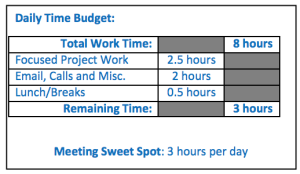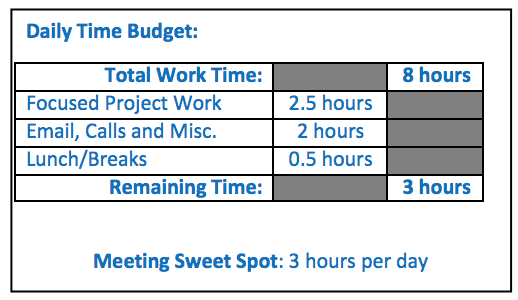As extroverted as I am, nothing makes me dread a day more than back-to-back meetings. All. Day. Long. It isn’t the meetings so much as all of the other things that pile up. It’s hard not to think about the deadlines, projects and emails while sitting through one meeting after another.
A meeting-obsessed culture can be unforgiving.
No more time to get your work done? Guess you’re bringing it home again.
No time to eat? No mercy.
Early in the morning? You can sleep on the weekend.
Meetings Are on the Rise
Meeting overload is rapidly becoming one of the top pet peeves in the workplace. With multiple projects, a push towards collaboration and technology making it easy to snag time in each other’s calendars, there is no surprise that we face meeting overload.
The challenge is that this leaves us with very little time to do our work. Inboxes are flooded, projects pile up, deadlines are missed, quality goes down and we all pay the price of inefficiency.
Meeting Sweet Spot
Without a doubt, meeting overload needs to be addressed at the corporate level. However, regardless of what our organization is like, we can start to correct a meeting imbalance ourselves. We start by defining our Meeting Sweet Spot.
Our Meeting Sweet Spot is the ideal amount of time we dedicate to meetings. This must be relative to everything else we are trying to fit into our day. For example, on any given work day, I have roughly eight hours available. During which, I have meetings to attend, projects to tackle and emails to address. I also like to take the occasional break. Sadly, I am not one of those people who “forgets” to eat lunch. (As far as I’m concerned, this mystery is right up there with the Cadbury secret – I’ll never quite understood how people forget to eat.)
With so much to fit into a limited amount of time, I need to actively keep things in balance. If I’m not careful, meetings steamroll everything else in their path.
I estimate that I need roughly five hours per day for all non-meeting activities. That leaves me with three hours per day (or 15 hours per week) for meetings. Since I need to commute/travel for some of meetings, I need to include this time in the meeting count.
Sure, I can add some “bonus” time if I want to squeeze more into the beginning or end of my day. Some people are notorious for throwing more time at a problem. And as much as I used (and abused) this approach in the past, I am not a fan of simply working more.
When my meetings creep up over their allotted 15 hours per week, I need to scramble to find that extra time. Maybe that means working into the wee hours of the night. Or maybe that means sacrificing project and email time. But these solutions just leave me feeling overworked, behind and frustrated. A better approach has been to manage around my meeting sweet spot.
Interestingly, once I became clear about my three-hour per day rule, I found it much easier to manage my calendar. This simple awareness has done wonders to help me better balance my time.
What is your meeting sweet spot? If you are managing a large team, your number is likely higher than mine. But if your work is piling up, you might be giving too much of your time to meetings. The first step is to calculate your meeting sweet spot.








Leave A Comment